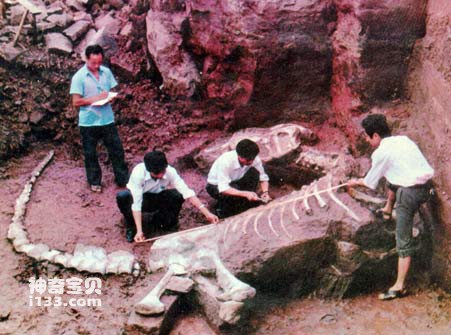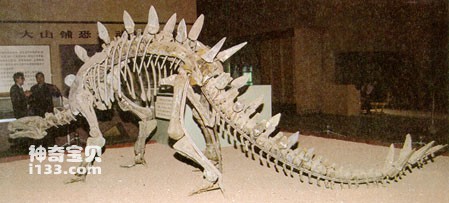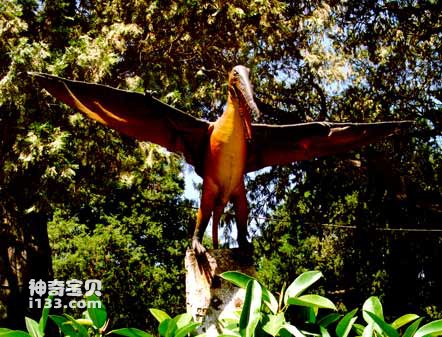The Dashanpu Fossil Site is located in the Dashanpu dinosaur fossil site in Zigong City, Sichuan Province, my country. It has attracted worldwide attention for its rich burial and complete preservation. Therefore, some scientists vividly call Dashanpu the "Dinosaur Cemetery". So, how did this "dinosaur cemetery" form? This mysterious question has attracted the interest of many scientists. They studied this problem from different angles and came to some conclusions. Although they cannot completely solve the mystery, they more or less provide a reference basis for us to finally understand this problem. Three theories are introduced below.

1. In situ burial theory:
This theory was proposed by Xia Zhijie, a petrology professor at the Chengdu Institute of Geology. It is based on petrology and the burial characteristics of dinosaur fossils.
Geologically, the buried strata of Dashanpu Dinosaur belong to the terrigenous clastic sediments of the Shaximiao Formation. They are mainly purple-red mudstone, interspersed with multiple layers of light gray-green medium-fine-grained sandstone and siltstone, and belong to alternating fluvial and lacustrine facies deposits. . In other words, in the middle Jurassic period 160 million years ago, the Dashanpu area was crisscrossed by rivers and lakes. Such a natural environment, coupled with the mild climate conditions at the time, made this place a complete "paradise" for dinosaurs to survive and reproduce. Groups of various dinosaurs lived on this lakeside plain with dense vegetation. However, it is likely that a large number of dinosaurs were poisoned to death due to eating plants with high arsenic content, and were quickly buried in a relatively calm sandy shoal environment. They were buried in situ before they could be transported. As a result, the taphonomic characteristics of this region are abundant and well-preserved dinosaur fossils.
This theory is unique because it conforms to the principles of taphonomy, but it still makes people feel that the evidence is insufficient, because what was the average background value of arsenic content in plants in the Dashanpu area at that time? What is the level of arsenic that could cause sudden death of dinosaurs? Are the samples taken when analyzing arsenic levels representative? These issues still require further in-depth research.
2. The theory of burial in different places:
This theory holds that the dinosaurs in Dashanpu were transported to this area and buried after they died in another place. The evidence includes: (1) If they are buried in situ, most of them should undoubtedly be complete or relatively complete individuals. On the contrary, the fact is that although more than 100 individuals of dinosaur fossils have been excavated and collected in this area, most of them are complete or relatively complete. There are only more than 30 individuals, accounting for only about one-fifth of the total. (2) Looking at the fossil site, in addition to the features of rich burial, complete preservation and easy discovery, there is a common phenomenon that is not easily noticed by people. The fossils near the upper part or the surface are fragmented and scattered, and most of them are dinosaur limb bones. And it looks like it has been worn to pieces after being transported; at the same time, the closer you get to the upper rock layer, the more small fossils, such as fish scales and various teeth, are scattered throughout the fossil site. The vertebrae of pterosaurs, stegosaurs and plesiosaurs are also very small. Sporadic, with a distribution pattern from south to north, from more to less. The lower rock formations are almost all composed of huge sauropod dinosaurs, and the preservation is incomplete. It is obvious that they were the result of transportation. (3) The discovery of gravel layers is an important basis for studying the depositional environment. The gravels found in Dashanpu are all located at the bottom of the fossil layer. Judging from their characteristics, they are products of transportation and may be closely related to the formation of dinosaur fossil groups.
3. Comprehensive theory:

The stegosaurus of Dashanpu

The pterosaur of Dashanpu
Most scientists believe that most of the fossils in the Dashanpu Dinosaur Cemetery were transported and buried, while a small number were buried in situ. Therefore, this is a dinosaur cemetery formed by a combination of two causes. Why are dinosaurs and other vertebrates so abundant in this area? If only one family of dinosaurs were buried here, both theories might be easier to understand, but in addition to dinosaurs, there are also flying pterosaurs, plesiosaurs, labyrinthine amphibians, etc. that live in the water. Their living environment Look different. Geological research has proven that Dashanpu in the middle Jurassic was a flood plain. These ancient reptiles may also have obvious selectivity for their living environment like modern animals. Among the dinosaurs, the mild-tempered sauropods often live in groups on low-lying lakeside plains; stegosaurus likes to live in mountain forests slightly higher than the lakeside and covered with perennial ferns; ornithopods are known for their light shape and structure. Flexible and good at running, it is active on higher platforms. Other vertebrates, such as pterosaurs, can only fly at low altitudes in lakeside forests. The living environments and habits of dinosaurs and these vertebrates are very different, but why are they buried together? Probably it could only have been moved from different locations; but why are there so many complete fossil skeletons? This is obviously the product of being buried in situ. In the end, it seems that there is only one explanation for these phenomena, that is, the formation of Dashanpu “dinosaur cemetery” is a combination of in-situ burial and ex-situ burial.
animal tags:
We created this article in conjunction with AI technology, then made sure it was fact-checked and edited by a Animals Top editor.